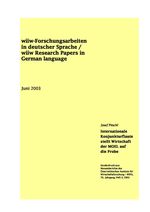Internationale Konjunkturflaute stellt Wirtschaft der MOEL auf die Probe (Reprint from: WIFO-Monatsberichte, Vol. 76, No. 5, May 2003)
Josef Pöschl
wiiw Research Report in German language No. 2003-06, June 2003
English Summary
Sluggish International Business Climate: A Test for the Central and Eastern European Countries' Endurance
The Central and Eastern European Countries (CEECs) were able to maintain in 2001 and 2002 a growth rate significantly above that of the EU 15. The more developed group of CEECs went more in parallel with the EU 15, which means that their average growth rate fell considerably. The other group of countries has not yet reached the pre-transition level. They were more independent from the international business cycle and maintained higher growth rates or even accelerated growth.
In the second half of 2002 a quite general tendency towards stronger growth became visible, not only from GDP data, but also from industrial output and foreign trade figures.
The background for this development is a fading of nominal appreciation tendencies, possibly in the context of the central banks' lowering of nominal interest rates. In several CEECs inflation stopped too -- in some cases price indices even declined for several months. The joint outcome of depreciation and no or low inflation was real depreciation. Especially in Poland this development strengthened competitiveness of domestic producers. Foreign trade was characterized by diminished growth rates compared to 2000, and at the same time also by higher export-import ratios. The specialization of exports on technically sophisticated finished goods continues. The CEECs are still countries with low GDP per capita, even if measured in purchasing power parities. The price gap compared to the overall EU 15 level remains large. In both respects differences between CEECs are also considerable.
Economic policies of CEECs are characterized by a relaxation of monetary austerity and continuous struggles with budget deficits.
For the EU budget the accession of eight CEECs will provoke additional net expenditures of EUR 5 to 10 billion for the first three years as a whole. For CEE governments, EU enlargement will provoke a major stress in terms of balancing of their budgets. The enlargement will require additional expenditures of both governments and enterprises. The latter will have to comply with EU rules, which in some cases will require massive investment into new equipment.
Austria's trade with CEECs shows a EUR 3 billion surplus, over 50 per cent of which the country achieves in the trade with countries on the territory of former Yugoslavia. Croatia and Slovenia are main sources of Austria's surplus, but Hungary remains by far the largest one. Austria's trade with Poland remains underdeveloped, as Poland's GDP corresponds to the aggregate GDP of the Czech Republic, Hungary, Slovenia and Slovakia, whereas Austria's trade volume with Poland equals that with Slovenia.
All in all, the ongoing testing of the CEECs' endurance so far produces quite good results, which gives reason for optimism in view of EU enlargement.
Zusammenfassung
Die Wirtschaft wuchs 2002 in den mittel- und osteuropäischen Ländern (MOEL) stärker als in der EU, und dies dürfte auch in den nächsten Jahren so sein. Dies gilt insbesondere für jene MOEL, die das BIP-Niveau von 1990 noch nicht wieder erreicht haben. In der Gruppe der wirtschaftlich fortgeschrittenen MOEL verlangsamte sich das Wachstum 2002 parallel zur internationalen Konjunkturflaute etwas, im zweiten Halbjahr 2002 zeigten sich aber Aufschwungtendenzen. Unterschiedliche Faktoren spielten dabei eine Rolle -- etwa ein Verschwinden des Aufwertungsdrucks auf einzelne Währungen, hohe Budgetdefizite oder hohe Lohnzuwächse. Eine Verbesserung der Handelsbilanzen zeugt von erhöhter Wettbewerbsfähigkeit der Unternehmen in den MOEL; sie spezialisieren sich in ihren Exporten immer stärker auf technisch hochwertige Fertigprodukte. Es spricht für die wirtschaftliche Reife der künftigen EU-Mitgliedsländer, dass sie von der derzeitigen internationalen Wirtschaftsflaute nicht stärker in Mitleidenschaft gezogen werden.
Keywords: transitional economies, comparative study, macroeconomic forecast, macroeconomic analysis. Statistics: country comparison, GDP by expenditures, foreign trade, balance of payments, employment, manufacturing, prices, wages
JEL classification: P2, O57, E17
